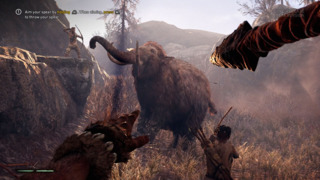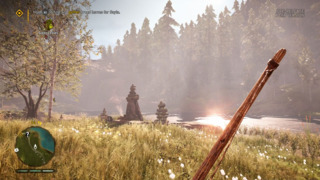Set twelve thousand years in the past, Ubisoft's upcoming open-world action game Far Cry Primal has its own take on how humans lived during the Stone Age. The game follows the journey of Takkar, a man who has been gifted with the unique ability to tame wild animals. His trials see him lead the Wenja tribe in a clash against the rival Udam and Izila tribes in a fight for survival. Evidently, the game takes some liberties with human history. To find out more about the how Ubisoft crafted it's own prehistoric language, designed the look of the tribes, and more, I sat down with lead writer Kevin Shortt to discuss the game.
GameSpot: Being based in the Stone Age, Far Cry Primal is a bit fantastical in nature. How do you draw the line between keeping it grounded in realism and exploring the fantasy of hunting in the Stone Age?
Shortt: Once we decided we were going to do it in 10,000 BC, we started with research. We spoke to anthropologists and linguists, as you can tell. We turned to linguists a lot to get that language right. We wanted to get some of those concrete things right. In 10,000 BC that is when the Ice Age has receded. The trees you'll notice are much bigger, the forest is lush and deep. And we wanted to get the animals right. The megafauna that we have that you don't have today. Getting that base was really important.
Once we got that, we knew that we still wanted to have fun with our colourful characters but they have to be grounded in the period. So we can't just go crazy and make up some wizard. They've got to make sense. So we have the shaman, which is reflective of the period. The Wenja is a tribe that believed in Animism, and that was very common back then. Animism is when you believe that everything has a spirit. From inanimate objects to people and animals. That's grounded in what we know of that period.
The other people that you're going to meet, they're going to be warriors, hunters--it's all roles that fit with the hunter-gatherer period. Crafting was big so you've to have a crafter. And then within that we make them crazy, bizarre, fun, unusual. That's where we get the fun and the flavour that players have come to know with Far Cry.

Is the language in Far Cry Primal a real language that was used?
No, it's not. But it's based on a real language. The game actually has three languages. There's Wenja, which is what your tribe speaks. There's Udam, which is what the Udam tribes speaks, then there's Izila, again what the Izila tribe speaks. They're all variations, so they're all similar, but there's distinct differences. That's why it was important to go to these linguists and get them to help us craft a proper language. These guys know Proto-Indo-European, and that's considered one of the first languages. It's where all our language comes from. That's a language that linguists know existed. So what they did, they looked at that language and they based our story and our language on that.
So you've invented a whole new language for the game?
Yeah! And what's great is that they didn't just translate what we wrote. We wrote our script and worked with them on that. They didn't go word for word, they really look at it as, okay, this language would have this structure. You can conjugate the verbs in their language. It's a real thing that I think fans are going to be able to… start to recognise what's being said. Most aren't going to end the game talking Wenja, but you're going to have a real sense of it.
Kingdom Come: Deliverance 2 - Official Cinematic Announcement Trailer Stellar Blade - BIBI ‘Eve’ Official Music Video Trailer | PS5 Apex Legends: Urban Assault Collection Event Trailer Total War: WARHAMMER III - Elspeth von Draken Gameplay Showcase Genshin Impact - "Arlecchino: Sleep in Peace" | Official Character Teaser Potionomics: Masterwork Edition - Official Announcement Trailer Sclash - Console Release Date Trailer Snowbreak: Containment Zone - "Gradient of Souls" Version Trailer Harold Halibut GameSpot Video Review Nancy Drew: Mystery of the Seven Keys | World Premiere Official Trailer Modern Warfare III & Warzone - Official Cheech & Chong Bundle Gameplay Trailer SteamWorld Heist II – Official Reveal Gameplay Trailer
Please enter your date of birth to view this video
By clicking 'enter', you agree to GameSpot's
Terms of Use and Privacy Policy
When it was confirmed that you would be writing a new story set in the Stone Age, what were some of the first ideas that came to your mind that were like, okay, we definitely have to include this?
The language was one. That was one of the first things we talked about. Do we want to go English or just whatever modern language each territory uses, or do we want to do something that's more grounded? That involved some discussion, because there are things you have to consider.
We did a test. We brought actors in, and we wrote the script. We worked with our linguists already, and we wrote the scripts; one in a more primitive English to reflect the period, and one in the Wenja language. The English one, it immediately was clear that it really popped, as in not right. It just doesn't fit the period. You've got this beautiful world, you've got these megafauna, megaflora, the whole thing, and then you've got English coming out of the actor's mouths, and it just felt wrong. So that was one we stuck with right away.
Megafauna was a big thing. Everyone immediately was like, "Sabretooth!" That was one that we needed right away. One I was happy with, which we got, was one that I didn't even know existed until we started doing research: the two-horned rhinos. We have woolly rhinos in the game, but there's a rare rhino that you can find that's a two-horned rhino. And it's based on what they actually had then. They have skeletons of these two-horned rhinos.

In 10,000BC people didn't quite look like how the actors look now. How do you explain that?
This period is a really violent, dangerous period. Everything is predatory against you. And you see that in our characters. You've got the shaman who's got burn marks all over his face. Ull, same thing. He's got scars across his face. We have a character who's missing an arm. They're all reflecting the world that they live in. These aren't scars that you can just go to the doctor and heal. You get them, and you live with them.
I think that's where we mostly reflect this period. In terms of the scars that they've got from the Primal world that they live in.
I was referring to more say, for example Sayla (pictured above)--her face she looks like someone who could exist today. Where we know for a fact that in 10,000BC that people had different skull structures.
Oh, okay. I mean yes and no--at that period there were still some similarities. Yes, it was 12,000 years ago and it's a long time ago, but we haven't radically changed. But we do have the Udam tribe, and they represent the older breed of humans that's dying out. You can see in their structure that it's much different and heavy set than the others.
Is it difficult as a writer to create a story that both fits in with and is as memorable as the random chaos that can emerge while playing Far Cry games?

For us in Far Cry Primal in particular, that was something that we wanted to hit head-on. Past Far Cry [games] have been a little more linear in terms of the way the story unfolds. For this one we really wanted to challenge that, and make sure that with your emergent gameplay, you can approach it how you want. It is entirely your call when you want to go and encounter these people. That, I think, is going to make for a nice unique flow for players. They're going to each be able to talk about their experiences. How they went through the game, and even in terms of main missions, they're going to be unique. Some might be like, oh I didn't meet the warrior until the end of the game, and some are going to meet the warrior right away.
Do you mean you can complete events out of sequence, in different order?
Yeah. There's no hardcore sequence you have to follow. The part you're playing right now at the beginning at the game, we want to make sure you're set up right. So that's got a slightly more linear flow. But once you've opened that up, the world is yours to go at as you wish. Including main missions.
Is there a certain state in which something has to be done to finish the game?
Yeah, we have certain things in which you do get a sense that the game is done. The game does have an end, it's not just perpetually ongoing. As with all Far Cry games, even when you finish the story the open world is yours to go do whatever you want. But yes, the narrative arc does have an end. You want to take on those two antagonists… I don't want to get into too much of exactly what happens, but you know. It's on you how you do it.
Players will able to explore Far Cry Primal's prehistoric world at their own pace when the game is released on February 23 for PlayStation 4 and Xbox One, and March 1 for PC.

